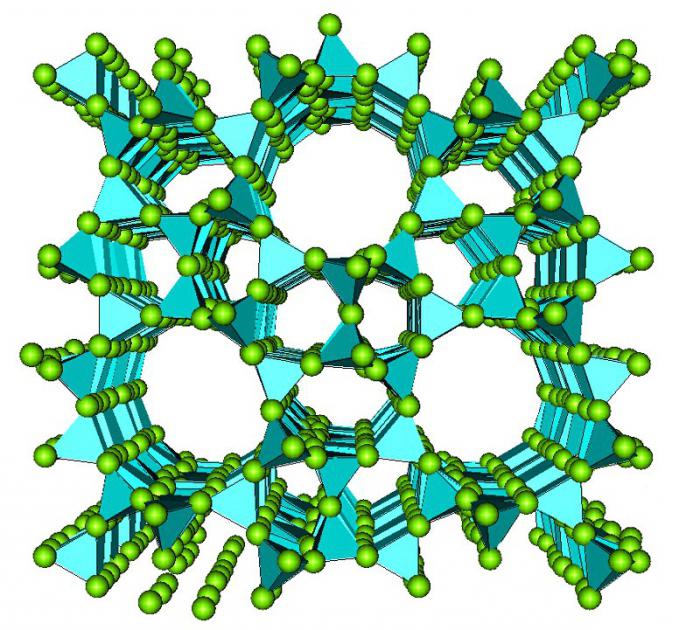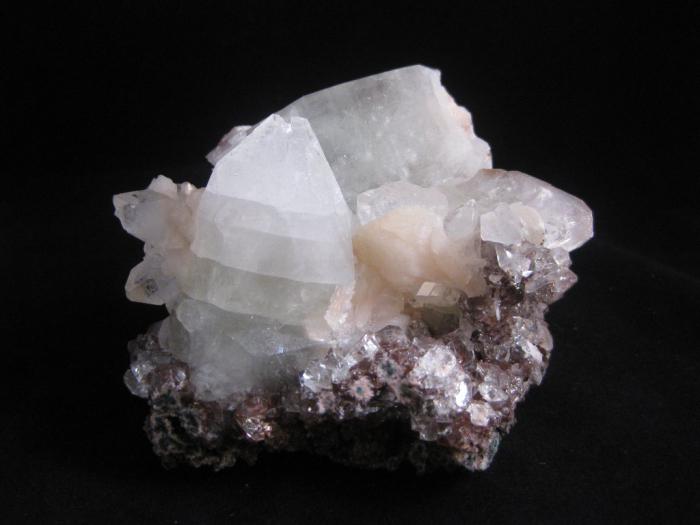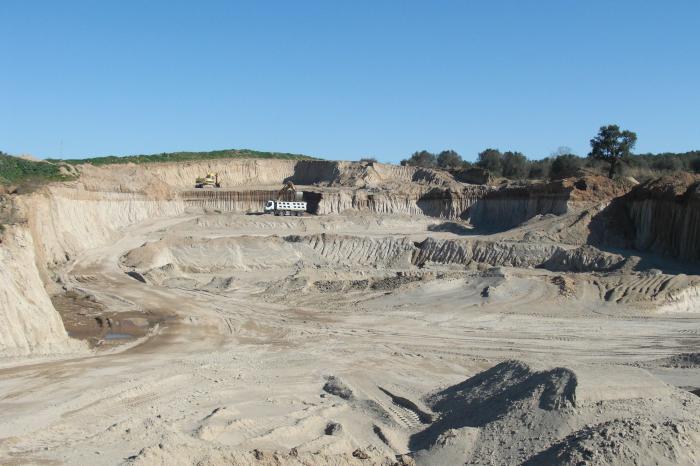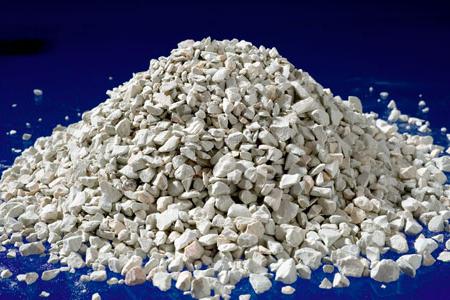The name of this amazing mineral comes from the Greek zeo - “boil” and lithos - “stone”, because when it is lowered into the water, it is bubbled with air for a long time.
Natural zeolite was first described in the XVIII century. Light mineral of various shades and density has sedimentary-volcanic origin, is widespread on the planet. Druze crystals of some types are interesting to stone collectors.
The French drug Smecta is well known to the common consumer; water with it is prescribed for infants with colic. It is made from synthetic zeolite.
Porous structure
Zeolite is a generalized name for framework aluminosilicates mined in deposits and obtained synthetically. Their crystalline structure is represented by tetrahedra of silicon and aluminum oxides, combined into lace frames with the same cavity size, filled with cations of alkali and alkaline-earth metals and water molecules. 
What is valuable and interesting zeolite? The properties of this stone to the absorption and loss of water without destroying the crystalline framework and the exchange of cations are used as a catalyst, sorbent, ion exchanger, molecular sieve. It is the porous structure and the diverse composition of ions that determine its quality, making zeolite indispensable for use in the chemical, nuclear, food industry, agriculture, everyday life and medicine.
Openwork crystals and dirty work.
Zeolite is an ion exchanger: it gives off potassium and calcium ions, other micro and macro elements, and instead takes toxic ions and holds them in its lattice.
Calcined mineral has an absorption capacity of up to 50% of the volume. Since the beginning of the 20th century, it has been used in petrochemistry for dehydration and refining of petroleum products, and for cement slurries in wells.
It is able to actively absorb not only water, but also a variety of chemical and biological contaminants: heavy metals, nitrates, pesticides, radionuclides, oils. It is used in gas and wastewater treatment plants of industrial enterprises.

Stop radiation!
Interest in zeolites intensified after the Chernobyl accident. Radioactive isotopes of cesium and strontium are dangerous for humans because the body perceives them as calcium and potassium ions and accumulates them. The liquidators had only alcohol and red wine to protect themselves from the inside.
Novosibirsk scientists led by academician Vasily Ivanovich Bgatov brought zeolite to Pripyat. It was ground in a mortar, mixed with water, and after the shift they watered the liquidators. Later it was concluded: those participants in the events who did not give up this "talker" had signs of radiation sickness in the form of weakness, changes in the leukocyte formula, and tooth decay manifested themselves to a much lesser extent.
In 1998, the drug “Litovit” created on the basis of this material was recognized as the best means for removing radioactive cesium and strontium from the body.
Without the use of zeolite, water supply to the settlements of Ukraine with water after the accident would have been impossible. Sokyrnite from the Transcarpathian field is used at all water intake stations of the Dnieper basin. They also disinfected the effluents discharged into Pripyat from the station. Passing a zeolite through a two-meter layer reduces water contamination with isotopes by two orders of magnitude.
After the Fukushima accident, zeolite bags were also used to absorb radionuclides, dumping them into the drainage system in order to reduce pollution of the water discharged into the ocean.

Mining and production
In the world there are about 1000 deposits where it is possible to extract natural zeolite (tuff) on a large scale. In the territory of the former USSR there were more than 20 of them - from Transcarpathia and Transcaucasia to Sakhalin. But the industrial value and need is such that from the middle of the last century, synthetic zeolite began to be produced. In it, part of the cations of alkali and alkaline earth metals is replaced by an alkylammonium ion. Dozens of species have been synthesized, some of which have no natural analogues. During the production process, the amorphous active mixture is structured at a temperature not exceeding 200 ° C.
Construction material

Slabs of Armenian tuff of almost thirty shades are famous as building and finishing material with excellent properties. They are faced with beautiful houses in Yerevan and many cities of the world.
It finds natural use as a filler in the production of high-strength concrete, for example, for hydraulic structures, monolithic construction. Waste from quarries and a synthetic product go to the production of foam and cellular materials, ceramic bricks.
The production of thermal insulation, film materials, refractory walls, cardboard, paper, varnishes, paints, plastics - zeolite is required everywhere.
Both for cats and for fish
A wide range of domestic applications is based on the fact that zeolite is a sorbent. Dehumidifiers for shoes, fillers for aquariums and cat's toilets, odor absorbers for refrigerators, fragrances, dry perfumes - this is not a complete list of useful products.
But zeolites in detergent are unlikely to justify the use. Replacing phosphates is good, but the mineral does not dissolve in water, is poorly rinsed, settles on things, which is especially noticeable when pressing dark tissues. But the zeolite nozzle on the hose that leads the water to the washing machine, eliminates the formation of scale and will save on detergents.
Living water
The use of zeolite for water purification makes it not only suitable for use, but also gives it unique properties. Passed through the filter, it becomes like a spring. You can not only drink it, but also bathe babies, use it for cosmetic purposes, water flowers and seedlings, germinate seeds, and pour it into the aquarium. Comparative studies show a high biological activity of zeolite-purified water. If there is no such filter, you can buy mineral pebbles (they are in the pharmacy), rinse, put in a three-liter jar, and preferably two. After 12 hours, water can already be used. From time to time, zeolite is dried and calcined, but after three months it is imperative to change. Used stones should not be poured into indoor flowers, as many harmful substances accumulate in them.

Who are lithophages?
The information that wild animals love to find and lick salt is not entirely true. Studies have shown that they lick and eat rocks formed during the destruction of rocks. These stones are not salty at all, but contain montmorillonite, clinoptilolite and other varieties of zeolites.
The phenomenon of eating stones, clay, chalk (or lithophagy) is widespread in nature among animals, among uncivilized peoples, sometimes children and pregnant women cannot resist this. Thus, they instinctively fill the need for minerals and are treated.
Stone of life

But you can not use inside all sorts of zeolites. Varieties with dangerous needle crystals can cause harm. In Russia, only one zeolite is certified for food and medical purposes - clinoptilolite of the Kholinsky deposit in Buryatia with an oval structure. About 20 years ago, the biologically active supplement “Litovit” - the stone of life - has been produced from it. The drug is produced in the form of powder, granules, tablets from one zeolite or with the addition of bran, chaga, probiotics, medicinal plants. It is approved for use and distribution in 10 countries of the world, the first certified in the program “Healthy nutrition - the health of the nation”.
Indications for its use are very wide: acute poisoning, chronic intoxication, allergies, metabolic disorders, hepatitis, bronchopulmonary diseases, various deficient conditions (anemia, osteoporosis, arrhythmia, convulsions) and their prevention.
It should be taken into account that the intake of Litovit should be divided in time with the use of drugs for at least an hour and a half, not to replace the treatment with it. This is an additional and preventive measure.
In the body, zeolite acts not only as a sorbent, cleansing of harmful substances, but also as a donor of necessary trace elements. They also make excellent scrubs and masks for cleansing and nourishing the skin of the face and body.
In science and medicine, it is needed for chromatography, purification of insulin and blood, does not violate the protein composition of biological fluids.
For milk yield and harvest

Zeolite has natural applications in agriculture as an effective mineral supplement for pets, large and small cattle, poultry and fish, as well as an improver for soils and fertilizer for plant nutrition.
Enrichment of the diet leads to healing, rapid growth, increase in weight gain, improve product quality. Brilliant smooth coat, good appetite, successful bearing of offspring, strong teeth, bones and eggshells, high milk yields - these are indicators of sufficient mineral intake in animals.
Zeolite is needed to improve soil properties. It is used for indoor flowers, in greenhouses, vegetable gardens, when arranging lawns, golf courses, planting trees, and is used for grain crops. Water permeability, aeration increase, soil acid and mineral composition normalizes. A single application of zeolite remains valid for 5 years. Plants get sick less, develop better, give a greater yield.
Attention to environmental issues makes us look for effective means of combating environmental pollution. Zeolite is an indispensable material for solving such problems.